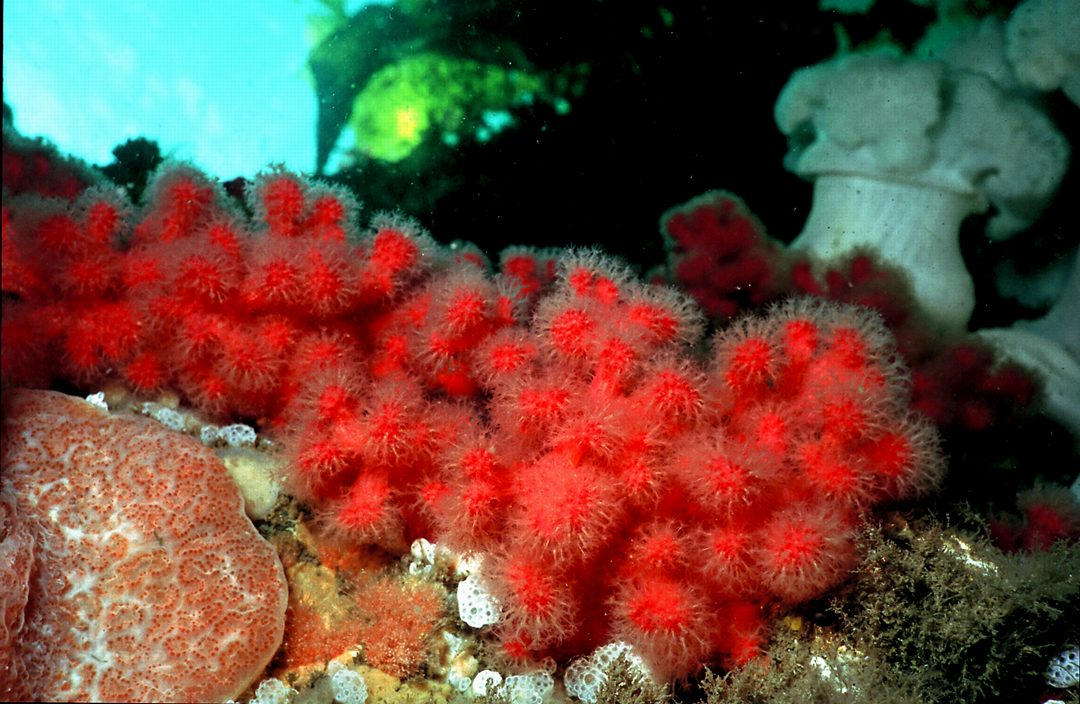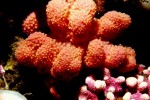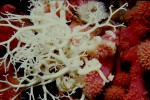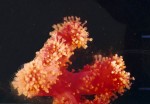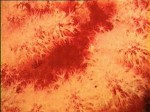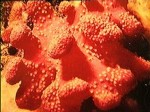In the following video, the soft pink coral Gersemia rubiformis is highlighted. It grows at 7-10 meters over a 3 square meter area off peg #3. note the retraction of the colony when it is disturbed. Also note the other associated invertebrates in the same area.
The following video shows in close details the characteristics of the soft pink coral (Gersemia rubiformis) found at Race Rocks. Soft corals are mostly sub-tidal. A soft coral has spicules of calcium carbonate within it, so it is moderately firm, but it does not have a completely calcified skeleton, like that of reef-building corals of warmer seas, or even like that of the cup coral of our coast. The polyps of soft corals have eight tentacles, each with delicate side branches. This establishes their relationship to sea pens and to most of the colonial reef-building corals. This colonial invertebrate forms a lumpy colony, sometimes 10 or 15 cm in diameter, whose colors range from cream through orange to deep pink elsewhere, but are consistently deep pink here at Race Rocks. The lumps, when the polyps have withdrawn, slightly resemble raspberries, which belong to the genus Rubus; hence the specific name rubiformis. Extended, the individual polyps stick out about 5mm beyond the lump to which they belong. Filmed by Jean-Olivier Dalphond and Damien Guihen on a sunny day at Race Rocks.
Gersemia rubiformis – a soft coral found underwater at Race Rocks. Usually it is found at the depth of 8 to 10 meters with an amazing variety of many other invertebrates. Here, no invertebrate is found growing on its own, they always occur in association with other invertebrates.
Gersemia occurs in fairly big pink patches in rather greater depths in the ocean but there are some small patches of it along the North cliff of Race Rocks. The lumpy colonies it forms usually are 10 to 15 cm in diameter.
Gersemia grows at the shallow depth because of the availability of nutrients there. Emerging from the walls are small pale pink polyps
Extended, the individual polyps stick out about 5 mm beyond the lump to which they belong. These polyps have small tentacles at the end. Each polyp has 8 of them, each with delicate branches which are able to catch masses of plankton for food. The vertical structure of the colony allows the polyps to be filter feeders and strain out plankton and other drifting organisms from the water column.
- Gersemia with polyps retracted, leaving yellowish mounds.. Here you can compare it with the hard pink hydrocoral.
- Gersemia with feeding polyps extended. Note background of Ascidian..
- We can find baby basket stars tucked into the lobules of the Gersemia. They obtain protection and a secure anchorage here.
- Macroscopic view of Gersemia undisturbed, with polyps extended. By Dr. Anita Brinckmann-Voss
- A close-up picture of the polyps extended in feeding mode
- Gersemia after the polyps had been disturbed. They withdrew slowly leaving gersemia without polyps sticking from its surface.
- Gersemia rubiformis Photo by Dr. A.Svoboda
Embedded within the body wall of the polyp are millions of microscopic, photosynthetic organisms, known as zooxanthellae. They live symbiotically, provide food and fuel and absorb many of the waste products of the polyp. Without the zooxanthellae, the corals could not exist. It is the zooxanthellae that contains necessary chemicals for the adequate production of calcium carbonate, for reef forming types of corals. However Gersemia does not have a completely calcified skeleton, like that of reef-building corals of warmer seas. Zooxanthellae are also responsible for providing much of the colour in corals, which usually range from cream through orange to deep pink elsewhere, but are consistently deep pink in Race Rocks.
CLASSIFICATION:
Domain: Eukarya
Kingdom: Animalia
Phylum: Cnidaria
Class: Anthozoa
Order: Alcyonacea
Family: Nephtheidae
Genus: Gersemia
Species: rubiformis
Common name: Sea Strawberry
 The Race Rocks taxonomy is a collaborative venture originally started with the Biology and Environmental Systems students of Lester Pearson College UWC. It now also has contributions added by Faculty, Staff, Volunteers and Observers on the remote control webcams. Ania Pawlicka——- PC yr 27, 2001 The Race Rocks taxonomy is a collaborative venture originally started with the Biology and Environmental Systems students of Lester Pearson College UWC. It now also has contributions added by Faculty, Staff, Volunteers and Observers on the remote control webcams. Ania Pawlicka——- PC yr 27, 2001 |
